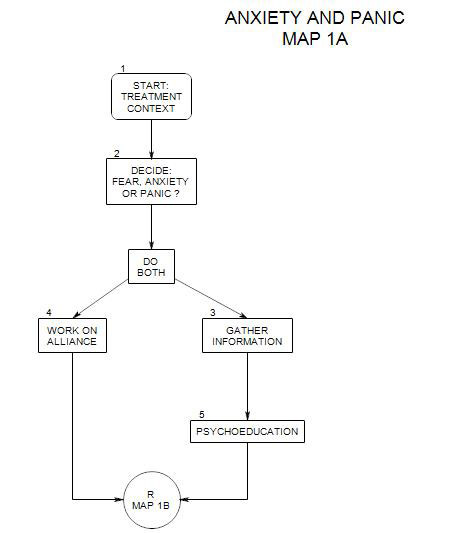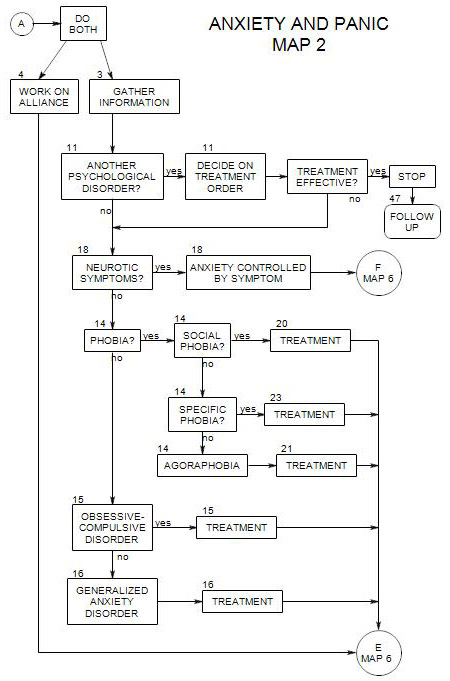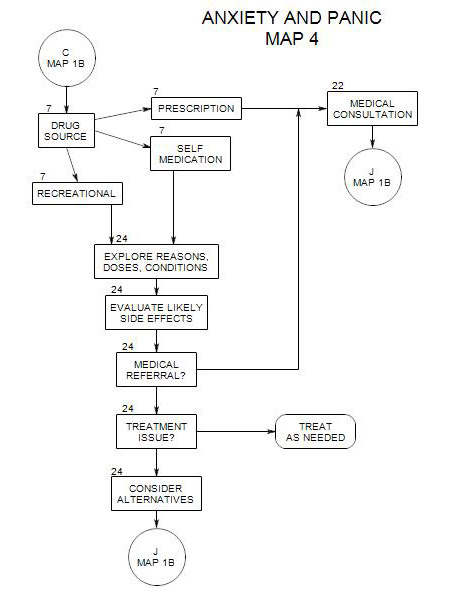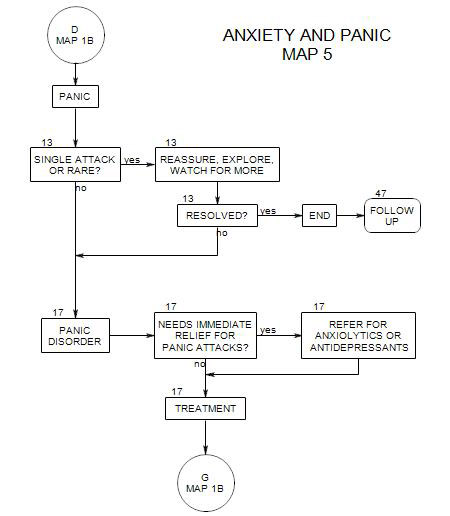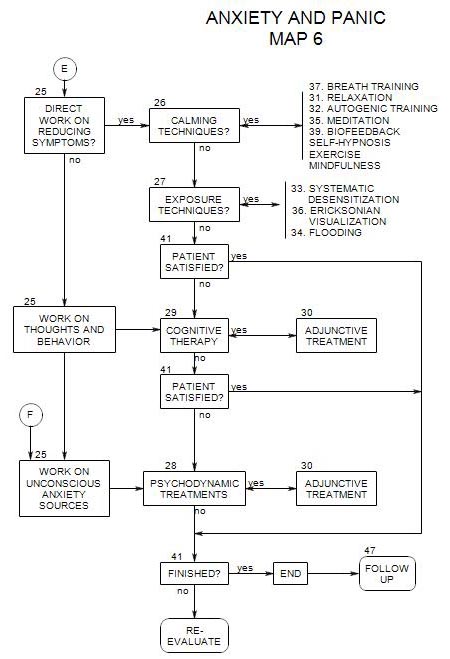(
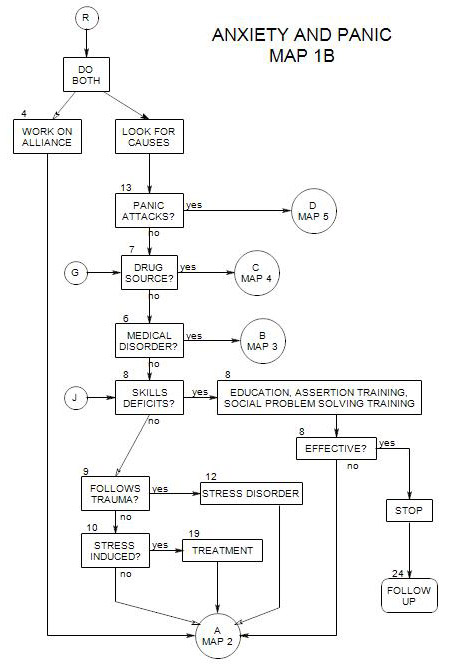
SECTIONS: 4 | 6 | 7 | 8 | 9 | 10 | 12 | 13 | 19 | 24
38a. Treatment of Medical Conditions Related to Anxiety
For many people, anxiety is related to a medical condition that must be treated. It may either be a direct cause of anxiety [as in mitral valve prolapse] or an indirect source of anxiety through its impact on their functioning. For those people, medical treatment is primary; and it is possible that their anxiety will abate once the medical condition is handled.
38b. Medication as the Primary Treatment for Anxiety
Medication could be the first choice for treatment of anxiety for a variety of reasons, for example:
- Many people are afraid of psychotherapy, want to avoid psychotherapy or consider medication to be the treatment of choice.
- Physicians may resort to their own armamentaria in handling psychological problems, and prescribe medication as the first line of treatment for anxiety.
- Many therapists, unaware of psychological treatments or unsure of their own skills, send patients to physicians for medications at the first sign of serious anxiety or panic.
People who begin with symptomatic relief through medication may never become psychotherapy patients. If they do get to a therapist, it may be for another issue, and they will see little value in opening up anxiety-producing topics for examination.
38c. Medication as Adjunctive
When the primary treatment is psychotherapeutic, medications can often be of value. For example:
- When the patient’s panic attacks are so disruptive that he/she is unable to function.
- When the patient is so anxious as to be unable to carry out recommended therapeutic procedures.
- When the patient is distrustful of psychotherapy and needs a sign of the therapist’s knowledge and sympathy in order to begin treatment.
In these cases, the goal is to reduce the power of the anxiety or panic temporarily while treatment is begun. It is usually best to inform the patient that medication will only be used until therapy can be effective without it.
It is often difficult to know when a person’s anxiety level is so great that medication is required, and when the person can manage without it. It can sometimes be helpful to ask the patient how disruptive the anxiety is, and whether he/she needs medication to get through the day. This can lead to a discussion of related issues and may inform subsequent treatment.
Dangers include the possibility that-
- prescription medication for anxiety will interact with other medications or substances that the patient is taking, with unpredicted , and possibly dangerous, results. Therapist-patient-physician contact is important, both when new medications are introduced, and when you learn about additional over-the-counter or recreational drugs that the patient is taking.
- the medication will be so effective in managing the patient’s symptom that motivation for the work of therapy is undermined. Then the patient could become continually dependent on the medication without making any lasting change or gaining personal control over the symptom.
- psychotherapy will be effective, but the patient will attribute change to the medication, undermining his/her own sense of success.
38d. Choice of Medication
BETA BLOCKERS
Beta blockers relieve some of the physiological symptoms of performance and social anxiety (Marshall, 1996, p. 124; Preston, O’Neal and Talaga, 2002, p. 195). These symptoms, dry mouth, palpitations, sweating, blushing, tremor, are the products of the neurotransmitter norepinephrine, which beta blockers suppress. The beta blocker in greatest use is propranolol [Inderal]; but others are also used [see Preston, O’Neal and Talaga, fig. 17c, p.197]
Preston, O’Neal and Talaga point out that the primary use of beta blockers is for hypertension, so that their continued use by people without hypertensive problems can lead to lowered blood pressure and dizziness. The natural conclusion is to use them only as needed and not frequently.
BENZODIAZEPINES
These medications are commonly prescribed for rapid relief from severe anxiety and panic symptoms. They are very quick-acting relative to other classes of medication. They are also effective for all of the anxiety disorders, with the possible exception of obsessive-compulsive disorder. In each case, all benzodiazepines appear to be about equally effective, and choices among them are typically based on their relative lengths of time to be effective and the time each takes to clear the body. (Mavissakalian and Ryan, 1997, p. 177) [link to online table]
When anxiety is episodic and relatively brief, short term benzodiazepines such as Lorazipam [Ativan] and Oxazepam [Serax] can be used. Their effect is rapid and they clear the body quickly.
High potency benzodiazepines such as Alprazolam [Xanax.], Clonazepam [Klonopin], or Lorazipam [Ativan] can be used for immediate control of panic attacks.
When treatment is ongoing, longer lasting benzodiazepines such as Clonazepam [Klonopin] and Chlordiazepoxide [Librium] can be administered less often and will maintain a relatively constant blood serum level (Mavissakalian and Ryan p. 177)
Although there is widespread concern for the addictive potential of benzodiazepines, the actual risk appears to be slight when they are properly administered and withdrawal is supervised. However, long-term use [6 months or more] is probably not advisable because of the risk of physiological dependence. (Mavissakalian and Ryan, p. 179; Preston, O’Neal and Talaga, pp. 196-199)
It is important to limit the length of time the person uses benzodiazepines and to taper off usage appropriately, because rebound from too rapid discontinuance can increase a person’s anxiety level. Often a benzodiazepine and an SSRI will be prescribed together, then the benzodiazepine tapered after a couple of weeks, as the SSRI takes effect
ANTIDEPRESSANTS
Many of the antidepressants, especially the SSRI’s have a dual function of relieving both depression and anxiety. For that reason, antidepressants are commonly used in the treatment of anxiety disorders.
All three classes [tricyclics, MAOI’s and SSRI’s] have been shown to be effective. [link to list] The SSRI’s are commonly preferred because they have fewer risks and dietary restrictions (Mavissakalian and Ryan, pp. 187- 192). Selection is generally made on that basis and on the side effects, which can include interference with libido, weight gain, and fatigue. (Mavissakalian and Ryan, p. 185).
Antidepressants can be used for longer term control of panic attacks. The exception is Buproprion [Wellbutrin], which may exacerbate panic attacks.
COMBINATIONS
It is not unusual for a purely medical solution to include an initial prescription for benzodiazepine along with an SSRI. The benzo provides immediate relief and is then tapered after a couple of weeks, as the SSRI begins to take effect (Mavissakalian and Ryan, p.194)].
